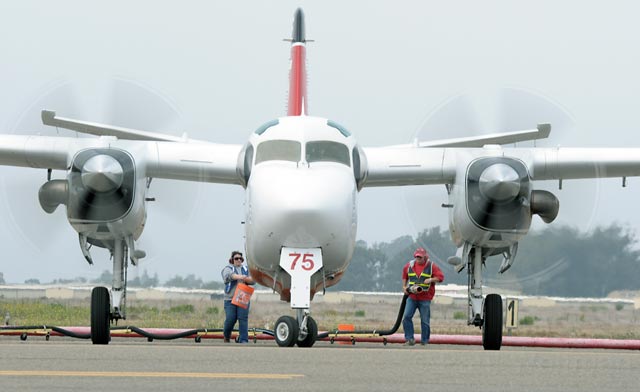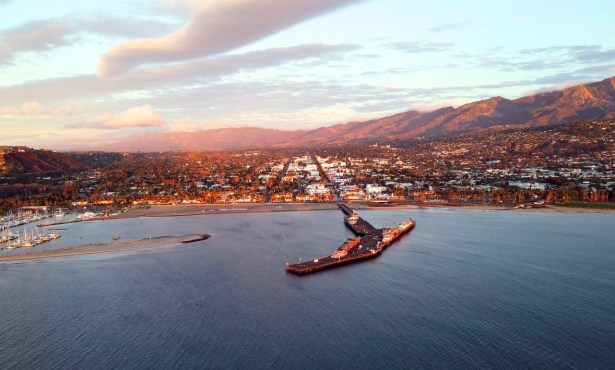High Fire Season Hits Hard
South Coast Put on Inferno Alert

With last week’s arrival of the so-called Springs Fire — wind-whipped and seemingly impossible to control until Sunday’s cold drizzle — High Fire Season officially hit the South Coast, roughly one month sooner than expected. But with all eyes peeled on the Ventura County blaze — which gobbled up 38 square miles of brush and damaged or destroyed 22 structures — there was little notice paid to the much smaller fire that triggered the activation of the air tanker base the National Forest Service maintains at the Santa Maria Airport.
That fire — dubbed the Rock Fire — consumed 51 acres of terrain 18 miles east of Santa Maria after target-practice shooters accidentally set off the blaze. The shooters — who larded their targets with illegal and explosive chemicals — notified authorities Saturday afternoon that they sparked the fire. The chemicals could have combined with driving winds and 95-degree temperatures to do far more damage than was inflicted, officials said. Firefighting teams dispatched to the scene found the hillsides inaccessibly steep, so four air tankers were called in. After a couple of runs to and from the Santa Maria base — the first time it was used this year — the pilots successfully laid down “a line of paint” and managed to box in the fire. Eventually it collapsed on top of itself as the temperatures dropped and a light rain fell. Early reports indicate that the shooters were criminally charged for their actions and will be given a bill for the costs of fighting the fire.
While the moral of that tale is pretty obvious — don’t shoot at exploding targets when it’s hot and windy — recklessness is hardly necessary to inadvertently trigger a fire of epic dimensions. As county fire chief Bill Dyer and his press officer David Sadecki explained at a ceremonial press conference Wednesday afternoon, fire conditions are all too ripe. Reflecting the region’s drought-like conditions, they explained, fuel moisture levels are alarmingly low for this time of year, and weather forecasters expect this summer’s temperatures will be unusually high. Grass fires are expected anytime, Sadecki said. Bigger fires, he added, can be expected by June, if not sooner.
Last year, the state maintained 10 incident-management teams to help area fire agencies combat backcountry blazes. This year, there are only six. “Just the budget,” Sadecki explained. As a result, area agencies will have to form their own incident-management teams to hold down the fort for at least three days. Fortunately, he said, that’s something county agencies have plenty of experience with. CalFire has 22 air tankers on hand to assist. By contrast, the U.S. Forest Service has only nine. About 10 years ago, that number was 42, but many of those Forest Service tankers were built during the Korean War. The stresses and strains of age — not to mention the aerodynamic challenges associated with zooming in and out of steep, tightly boxed canyons — have taken their toll. Several years back, many of the air tankers were put out to pasture after the wings were ripped off a similar make and vintage. Today, the Forest Service euphemistically refers to the bulk of its fleet as “legacy” aircraft.
Last week, the Forest Service announced the issuance of several new contracts that will bring seven new “next generation” tankers online sometime this year. These planes, which cost the government $160 million, can carry bigger loads and fly considerably faster than the rest of the Forest Services fleet, meaning they can lay down more retardant in less time. But whether they’ll be available in time for this year’s outbreak of forest fires remains to be seen.
Sadecki, for one, is not holding his breath. Given that last year was the third-worst fire season in more than 50 years — with 9.3 million acres engulfed — the issue finally achieved sufficient critical mass to generate congressional action. Ultimately, Congress indicated it hopes to build up its fleet of next-generation aircraft to 26. In the meantime, however, the Forest Service will rely on its much-reduced fleet of legacy tankers and will lease eight more from the Department of Defense and three “Very Large Airtankers” from private contractors. Even assuming all 26 are up and operational, that’s still roughly half what the Forest Service could field 10 years ago. In the meantime, representatives of all the county’s firefighting agencies confer each day at 8:30 a.m. to plot out potential deployment strategies.
In the event of red-flag warnings — dictated by the right combination of heat, dryness, and wind — Sadecki said additional firefighting resources can be put on call and dispatched in advance to anticipated trouble spots. The Forest Service maintains different levels of advance-warning stages for fire alerts. Rather than “High Fire Season,” it has levels I, II, III, and IV. Currently, the South Coast conditions are ranked at Level I. But by the end of May or beginning of June, chances are good the region will be elevated to Level III. At that time, target shooting will no longer be allowed on Forest Service land.
In the meantime, the county is asking residents to keep a defensible clear space of no less than 100 feet between their homes and nearby brush. Sadecki is also hoping to better acquaint the public on the difference between an evacuation warning and an order. It’s time to pack up when the warning is issued; it’s time to hit the road, he said, when the order is given. Residents should know, he also said, that such warnings can be issued by a multitude of ways, not just Reverse 9-1-1 calls. “People don’t need to wait to be told,” he added. “If you feel threatened, leave.”


